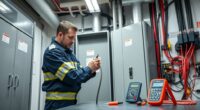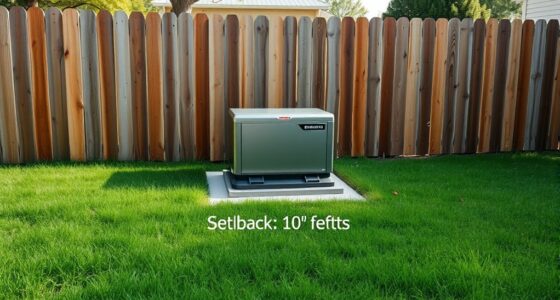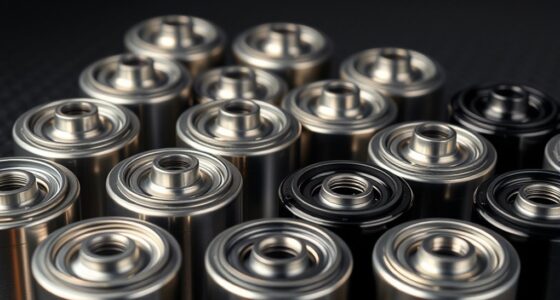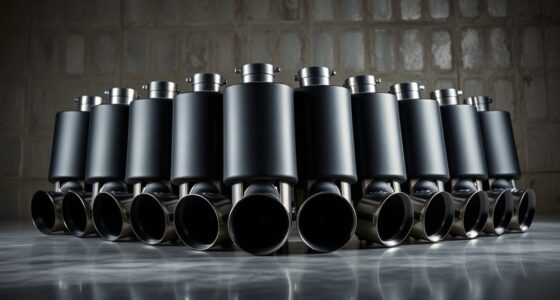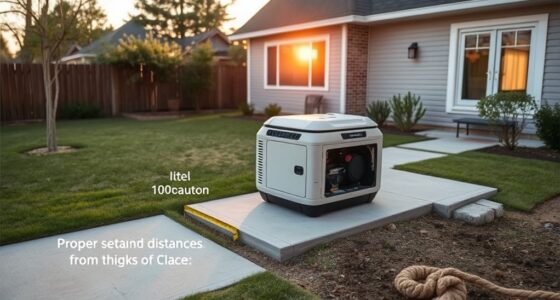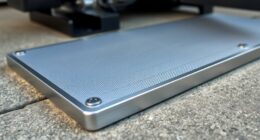To guarantee safe, efficient operation, place your generator at least 5-10 feet from your home and on a stable, non-combustible surface. Keep it away from windows, vents, and flammable materials, and direct exhaust gases away from living areas. Follow local building codes and set proper distances from gas lines and other structures. Make sure there’s easy access for maintenance and install transfer switches properly. Keep these guidelines in mind to avoid common mistakes and stay safe—there’s more to learn.
Key Takeaways
- Keep generators at least 5-10 feet from structures, windows, vents, and flammable materials to ensure safety and proper ventilation.
- Position on stable, non-combustible surfaces like concrete or gravel for stability and fire safety.
- Direct exhaust gases away from homes, vents, and air intakes to prevent indoor fumes and carbon monoxide buildup.
- Follow local setback and noise regulations, and install transfer switches nearby for safe, quick electrical connections.
- Regularly inspect the area for debris, shifts, or hazards to maintain safe operation and compliance.
Maintain Proper Distance From Your Home and Structures

To guarantee safety and compliance, you should always keep your generator at a safe distance from your home and other structures. Proper generator placement is essential to prevent hazards like carbon monoxide buildup and fire risks. Check your local setback regulations to determine the minimum distance required between your generator and your house, garage, or nearby buildings. These regulations vary by location but generally recommend placing the unit at least 5 to 10 feet away from windows, doors, and vents. Avoid placing your generator too close to enclosed spaces to ensure safe operation and easy access for maintenance. Following these setback rules not only keeps you safe but also helps you stay within legal requirements. Always consult local codes before installing your generator.
Consider Ventilation and Exhaust Placement
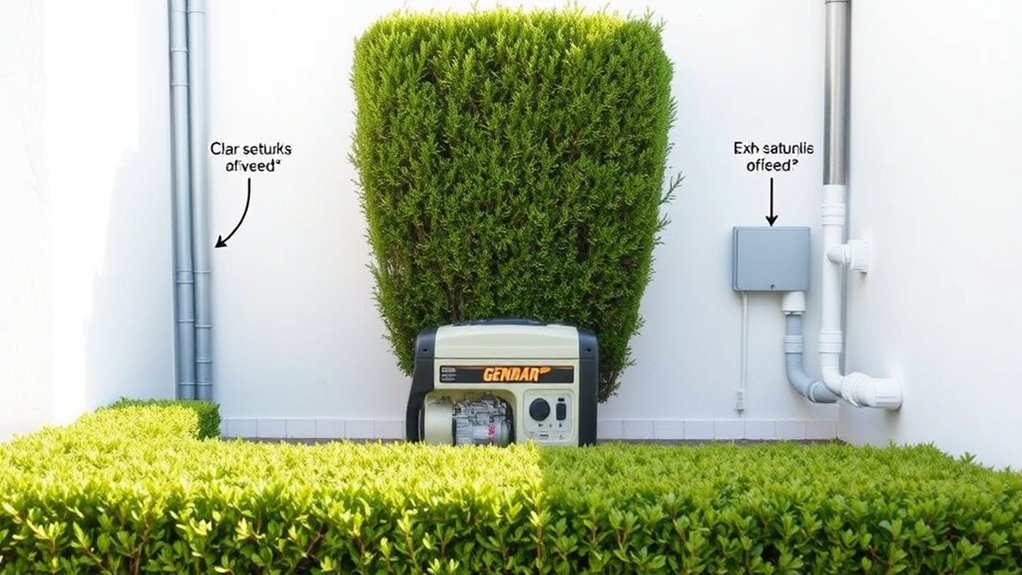
Proper ventilation and exhaust placement are essential to guarantee your generator operates safely and efficiently. Good airflow management prevents dangerous buildup of carbon monoxide and keeps the engine cool. Position your generator so that exhaust gases are directed away from windows, vents, and outdoor living spaces. Proper exhaust placement minimizes the risk of fumes entering your home or nearby structures. Keep the exhaust outlet unobstructed to allow for effective dispersal of gases, which maintains safe air quality around your generator. Remember, inadequate ventilation can cause overheating and dangerous fumes, so always choose a location with clear airflow pathways. Regular maintenance, including chimney and flue cleaning, ensures that exhaust systems function correctly and safely. By paying attention to airflow management and exhaust placement, you ensure your generator runs smoothly while keeping your environment safe.
Avoid Placing Generators Near Windows and Vents
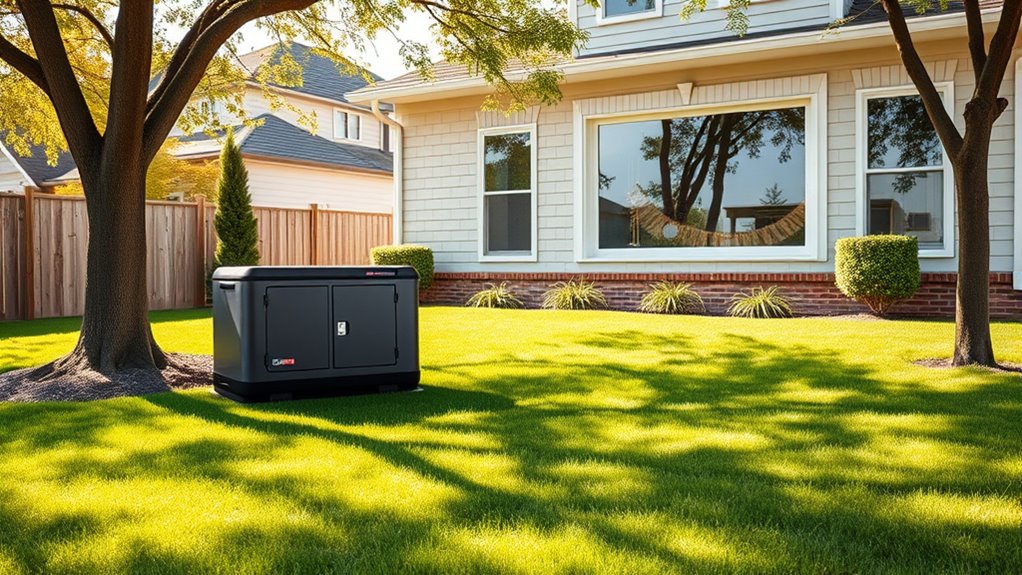
Placing a generator too close to windows or vents can cause dangerous fumes to enter your home or outdoor living areas. Poor generator ventilation increases the risk of harmful exhaust fumes seeping inside, especially near open windows or vents. Additionally, generator noise can be amplified if placed too close to living spaces, causing discomfort and disturbance. To guarantee safety, keep your generator at a safe distance from windows, vents, and air intakes. Proper placement helps prevent fumes from infiltrating your home and reduces noise disruptions. Remember, good ventilation isn’t just about airflow; it’s about containing exhaust gases and minimizing noise pollution. Maintaining adequate setbacks protects your indoor air quality and keeps your outdoor space comfortable and safe. Necessary cookies help ensure your safety and optimal operation by enabling essential site functions.
Follow Local Building Codes and Regulations
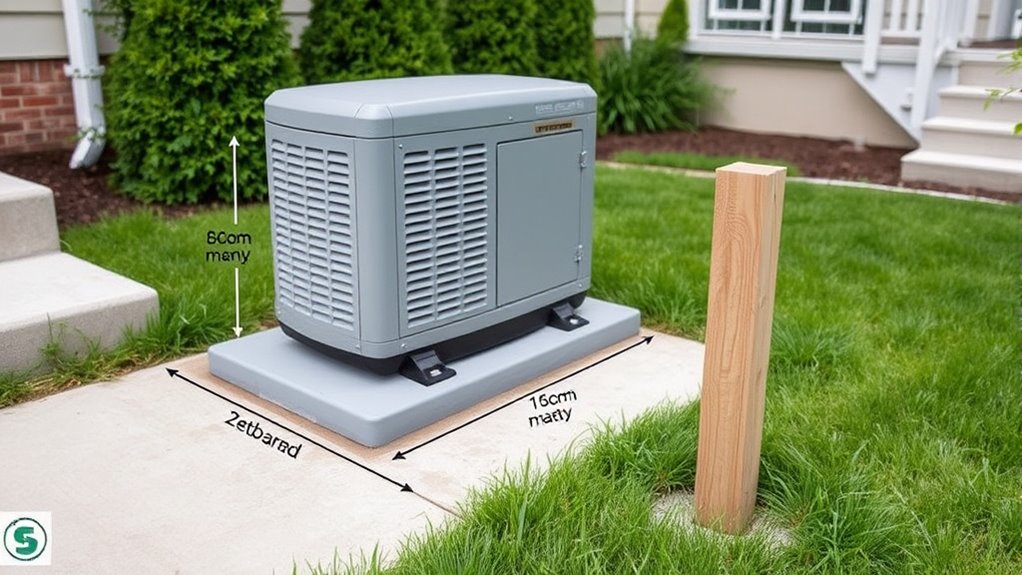
Following local building codes and regulations is essential to guarantee your generator is installed safely and legally. These rules often specify setbacks, ensuring your generator is positioned to reduce noise pollution and protect your property. Proper adherence can improve fuel efficiency by minimizing unnecessary strain on the generator caused by improper placement. Regulations may also address ventilation requirements to prevent dangerous fumes from accumulating, enhancing safety. Ignoring local codes can lead to fines or costly modifications later. Additionally, understanding local regulations can help you select the appropriate location that complies with environmental standards. By following these guidelines, you help ensure maximum noise reduction and energy use, making your generator more efficient and less disruptive. Always check with your local authorities or building department before installation to confirm you’re compliant with all applicable rules and regulations.
Choose a Stable and Level Surface for Installation
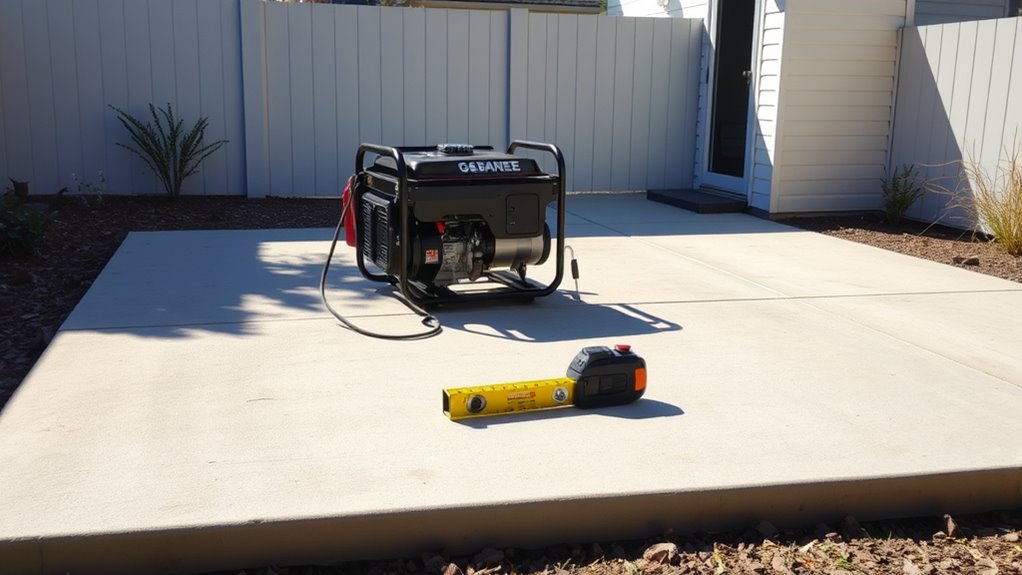
You need to find solid ground for your generator to sit on. A stable, level surface prevents excessive vibration that can cause damage over time. Taking the time to choose the right spot will keep your generator running smoothly and safely. Additionally, ensuring your installation area is free of clutter and hazards can help maintain safety and accessibility. Pinball machine weight considerations can inform the size and stability requirements of your installation spot.
Find Solid Ground
Choosing a stable and level surface is essential for safe and effective generator operation. You need to assess the ground stability carefully before installation. Conduct a thorough terrain assessment to identify soft spots, uneven patches, or loose soil that could cause instability. Solid ground ensures your generator remains steady during operation, reducing the risk of tipping or excessive vibration. Look for a flat, compact area with good drainage to prevent water accumulation and potential damage. Avoid placing your generator on loose gravel, muddy ground, or slopes. A firm, level surface provides a secure foundation, enhances performance, and prolongs the life of your generator. Taking the time to find solid ground now saves you from costly repairs and safety issues later. Additionally, creating a dedicated workspace helps in maintaining a consistent and safe setup environment.
Prevents Vibration Damage
A stable, level surface not only keeps your generator steady but also helps prevent damage caused by excessive vibration. When you choose the right foundation, you reduce stress on components and extend your generator’s lifespan. Use vibration isolation techniques, like rubber pads or anti-vibration mounts, to absorb shock and minimize noise. Proper soundproofing techniques, such as installing mats or enclosures, also dampen vibrations and noise transmission. Ensuring your generator sits on a flat, stable surface prevents uneven wear and potential mechanical failure. Consider these tips:
- Use rubber pads or anti-vibration mounts
- Install on a concrete or compacted gravel base
- Add soundproofing mats for extra vibration control
- Avoid soft or uneven ground
- Regularly inspect for shifts or instability
- Vibration management techniques help protect your generator’s internal components and maintain optimal performance.
Protect Your Generator From Elements and Moisture
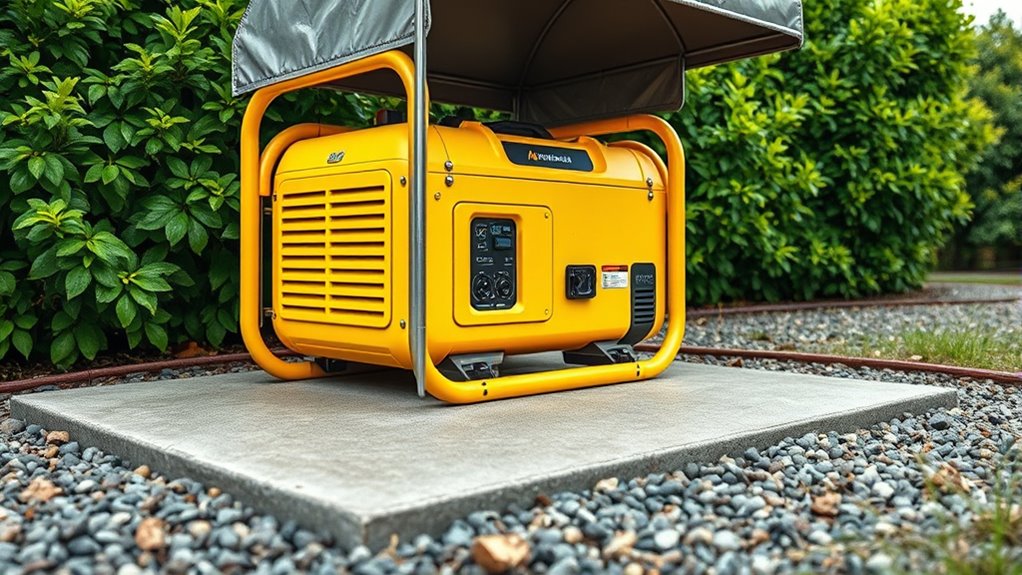
Protecting your generator from the elements and moisture is essential to guarantee its longevity and reliable performance. Proper weather protection prevents damage caused by rain, snow, and extreme temperatures. Use a sturdy, weather-resistant canopy or enclosure to shield it from direct exposure. Installing moisture barriers, such as a concrete pad or elevated platform, keeps water away from sensitive components and prevents rust. Ensure proper ventilation to avoid heat buildup and moisture condensation. Avoid placing your generator in low-lying areas prone to flooding or areas with poor drainage. Regularly inspect protective covers and barriers for tears or deterioration, replacing them as needed. Additionally, Smart Toilets incorporate sensors and self-cleaning features that can be affected by moisture exposure, so maintaining dry surroundings helps ensure their proper operation. Taking these precautions ensures your generator stays dry, functional, and ready when you need it most.
Ensure Easy Access for Maintenance and Refueling
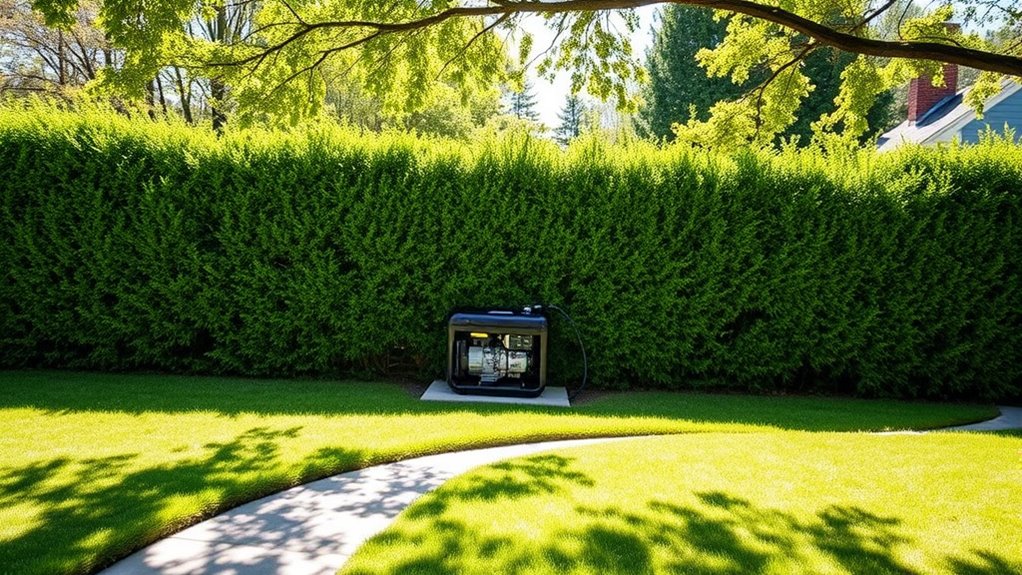
To guarantee your generator remains functional and easy to maintain, it’s important to select a location that allows for quick access to maintenance points and refueling. Proper placement helps you perform routine checks, refuel efficiently, and ensure maximum fuel efficiency. Additionally, accessible placement can contribute to noise reduction, keeping your environment quieter. Consider these tips:
- Position the generator where refueling is straightforward without obstacles
- Choose a spot with clear access for routine inspections
- Ensure enough space for servicing parts and replacing filters
- Avoid tight or cramped areas that hinder maintenance
- Think about sound barriers to help reduce noise during operation
- Incorporate considerations for AI-powered diagnostics to monitor your generator’s performance remotely.
Keep Away From Flammable Materials and Gas Lines
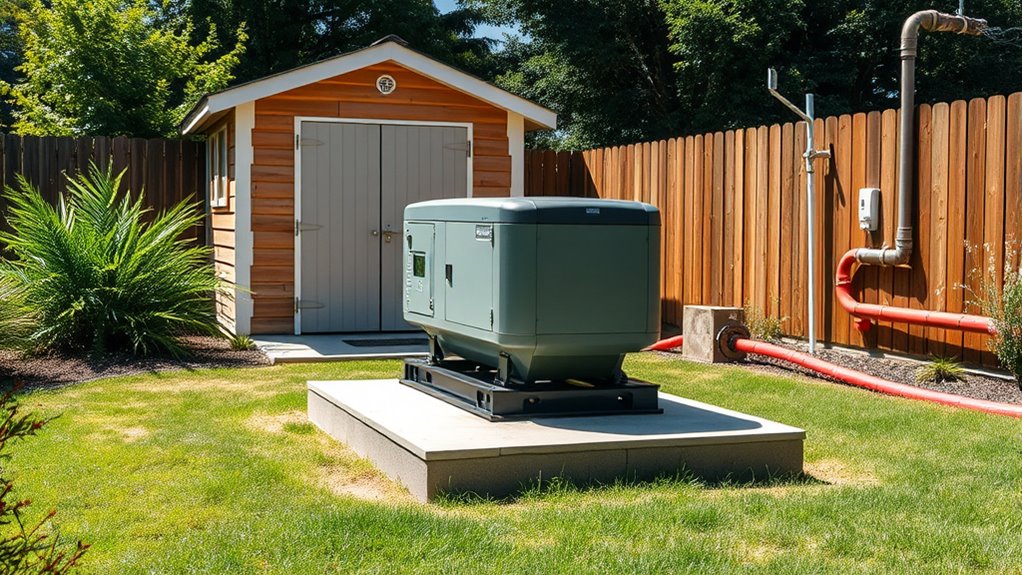
You should keep your generator a safe distance from flammable materials and gas lines to prevent fires. Avoid placing it on combustible surfaces like wood decks or near propane tanks. Always check the proximity of gas lines to make sure they aren’t at risk of damage or leaks. Using a self-watering plant pot can help maintain proper moisture levels around sensitive areas, reducing the risk of fire hazards caused by dry or overgrown vegetation.
Maintain Safe Distance
Maintaining a safe distance from flammable materials and gas lines is essential when placing a generator. Proper spacing helps prevent fires and guarantees safe operation. Keep in mind that larger generators tend to produce higher noise levels, so distance is even more important. To stay safe:
- Place your generator at least 15-20 feet away from the house and combustible surfaces
- Keep it clear of gas lines to avoid leaks or accidents
- Ensure the exhaust is directed away from windows and vents
- Use barriers or enclosures to reduce noise impact without compromising safety
- Regularly inspect the area for flammable debris or materials nearby
Avoid Combustible Surfaces
Avoid placing your generator on or near combustible surfaces, as these materials can easily catch fire if the generator produces sparks or leaks fuel. Fire hazards increase markedly when generators sit on wood decks, dry grass, or other flammable materials. Always choose a non-combustible surface like concrete or asphalt to minimize risk. Keep the generator away from structures, wooden decks, and any areas with dry leaves or paper, which can ignite quickly. Ensuring it’s on a stable, fire-resistant surface helps prevent accidental fires caused by heat or sparks. Remember, combustible surfaces can turn a small spark into a dangerous blaze rapidly. Being cautious about the placement reduces the chance of fire hazards and keeps you and your property safe.
Check Gas Line Proximity
Since gas lines are highly flammable, it is vital to keep your generator well away from both gas pipes and any combustible materials. Maintaining proper fuel line clearance prevents dangerous leaks or fires. Always check the gas line proximity before placing your generator to avoid accidental damage. Make certain there’s sufficient space to prevent heat and sparks from reaching gas pipes. Keep these points in mind:
- Maintain a safe distance from gas lines
- Check for any signs of leaks or corrosion
- Avoid placing the generator near propane tanks
- Ensure proper clearance around fuel lines
- Never block ventilation that could lead to heat buildup
Plan for Proper Electrical Connections and Transfer Switches

To guarantee your generator operates safely and efficiently, you need a solid plan for proper electrical connections and the installation of transfer switches. Start by carefully considering transfer switch placement; it should be installed close to your main electrical panel to allow quick switching during outages. This placement minimizes wiring length and reduces potential safety hazards. Ensuring electrical connection safety is critical—use appropriately rated cables and follow local electrical codes. Proper wiring prevents overloads and short circuits, protecting both your system and household. Always hire a licensed electrician to handle connections and transfer switch installation. This ensures compliance with safety standards and guarantees reliable operation. A well-planned setup minimizes risks and ensures your generator provides power efficiently when you need it most.
Check Setback Requirements Before Installation
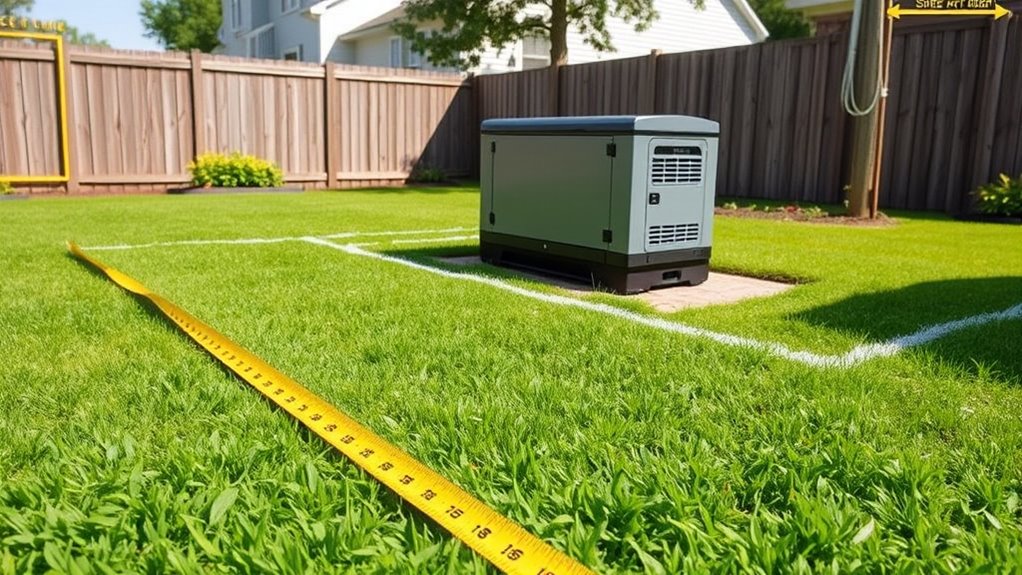
Before installing your generator, it’s important to review local setback requirements. These regulations ensure safe distances between your generator and property lines, neighbors, and structures, minimizing noise levels and environmental impact. Ignoring setbacks can lead to fines or the need to move your unit later.
Review local setback requirements before installing your generator to ensure safety and compliance.
- Confirm minimum distances from property lines and structures
- Check local noise level restrictions to avoid disturbances
- Ensure proper ventilation to reduce environmental impact
- Verify clearance for maintenance and refueling access
- Understand rules for setbacks near wetlands or protected areas
Following these requirements protects your property, prevents neighbor disputes, and guarantees your generator operates efficiently without disturbing others or harming the environment. Always consult local codes before making your final placement decision.
Frequently Asked Questions
Can I Install a Generator Indoors Safely?
No, you can’t install a generator indoors securely. Generators produce dangerous fumes like carbon monoxide, which can quickly fill enclosed spaces and cause poisoning. Always follow setback regulations to guarantee proper ventilation and safety. Keep generators outside, away from windows, vents, and doors, to prevent fumes from entering your home. Ignoring these safety tips risks your health and safety, so never compromise on outdoor installation for your generator.
What Noise Levels Are Acceptable Near Residential Areas?
You should aim for noise levels below 60 decibels near residential areas, respecting local noise restrictions. To keep noise down, consider soundproofing tips like installing enclosures or barriers around your generator. Regular maintenance also helps reduce noise. Keep your generator well-maintained and ensure it runs smoothly, and you’ll minimize disturbance to neighbors while complying with noise regulations.
How Often Should I Perform Maintenance on My Generator?
You should perform maintenance on your generator every 50 to 100 hours of use or at least once a year, whichever comes first. Regular checks help extend the generator lifespan and keep it running smoothly. Follow a maintenance checklist that includes inspecting oil levels, changing filters, and testing the battery. Staying consistent with maintenance guarantees your generator stays reliable when you need it most.
Are There Specific Brands Recommended for Beginner-Friendly Generators?
When it comes to generator brands, there are some beginner-friendly options that are worth considering. Brands like Honda, Yamaha, and Champion are known for their reliability and ease of use, making them a refresh of fresh air for newcomers. These brands are like a gust of fresh air, offering sturdy performance and user-friendly features. Stick to these and you’ll be up and running in no time, without feeling overwhelmed.
What Are the Consequences of Ignoring Setback Regulations?
Ignoring setback regulations can lead to serious consequences. You might face noise complaints due to increased generator noise, disturbing neighbors or violating local ordinances. It also risks setback violations, which could result in fines or your generator needing to be relocated. Additionally, improper placement might cause safety hazards, such as carbon monoxide buildup or fire risks, putting you and others in danger. Always follow setback rules to avoid these avoidable issues.
Conclusion
By following these generator placement rules, you’ll guarantee safe, efficient operation and peace of mind during power outages. Did you know that improper placement can increase carbon monoxide risks by up to 80%? Staying mindful of setbacks and safety guidelines not only protects your family but also extends your generator’s lifespan. So, take the time to plan wisely—you’ll be prepared, safe, and ready when it matters most.

